This is a Fujica 35 Automagic, a 35mm scale focus camera made by Fuji Photo Film Co. LTD starting in 1961. Although an entry level camera, it was one of the very first Japanese made 35mm cameras with automatic exposure. Using the built in selenium “electric eye” below the lens, the camera could automatically pick an appropriate f/stop given the available light. The shutter is capable of only two speeds, one of which was available in auto exposure mode. This camera was likely not in production long and finding information about it online has been extremely difficult. Still, this was a handsome little camera with a solid metal body and a decent lens that when used to it’s strengths, was capable of nice photographs.
Film Type: 135 (35mm)
Lens: 3.8cm f/3.4 Fujinar-K coated 3-elements (probably)
Focus: 2.5 feet to Infinity with Click Stops for Portrait, Group, and Scenery
Viewfinder: Scale Focus Galilean
Shutter: Twin blade spring loaded
Speeds: 1/40 and 1/200-ish seconds
Exposure Meter: Coupled Selenium Cell w/ Programmed AE
Battery: None
Flash Mount: Coldshoe and Flashbulb Sync
Weight: 476 grams
Manual: None
How these ratings work |
The Fujica 35 Automagic is an enigma of a camera that seemed to come and go without much fanfare. Sold in 1961 for less than $40, the camera was an entry level camera with only two shutter speeds, and a fully automatic auto exposure mode via a built in selenium exposure meter. The camera has a semi wide angle 3.8cm lens and shoots very distinct images with heavy vignetting on the sides. With a solid build quality, sharp lens, and decent viewfinder, the camera is extremely easy and fun to use. It’s not a camera that was very common and they can be hard to find in working condition, but it’s low price, curious looks, and decent quality images make it worthy of addition to any collection. | ||||||
| Images | Handling | Features | Viewfinder | Feel & Beauty | History | Age | |
| 1 | 1 | 1 | 1 | 2 | 0 | 30% | |
| Bonus | none | ||||||
| Final Score | 7.8 | ||||||
History
The Fujica 35 Automagic is a camera that appeared on the market sometime in the early 2000s. It was available for sale exclusively through online auction sites like eBay and buyee.jp for review on vintage camera blogs like this one.

Okay, I’m kidding of course but had that been the case, the history section for this camera would likely be no different as I’ve been able to find practically no information about this model anywhere on the Internet. No reference to it’s origins on the few Japanese language sites I’ve found it mentioned. No scans of magazine ads or articles from when it was first sold.
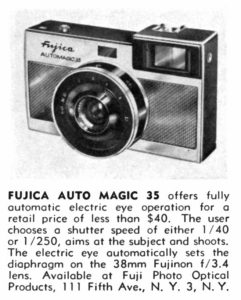
Even the date of it’s release is a mystery as some sites say 1958, while others claim 1961. In early drafts of this article, I believed 1958 was correct as that would have coincided with a huge rash of similarly basic 35mm “electric eye” cameras hitting the market on the onset of the auto exposure age, however after some extensive digging, fellow enthusiast Marc Bergman alerted me to several trade show guides from 1961 to 1964 that show the Automagic during that period for sale at a price of $39.95 which translates to about $340 today.
It is possible this was a North American exclusive camera designed to drum up interest in the Fujica brand by entry level photographers. The plate on the rear door of the camera written entirely English, and the focus scale in feet rather than meters, suggests this was primarily exported to North American countries.
Beyond this, I have nothing else to tell you about this camera. I attempted to reach out to email addresses on a couple Japanese sites hoping to connect with someone more familiar with this camera, but as of this writing, I’ve received no responses. Even my usual sources of period advertisements and articles had nothing. It’s not often that I come up empty handed in my research, but this one seems to have gotten the best of me.
If anyone reading this has more background info on the camera, when it was made, how much it might have cost, a review, or even the user’s manual, please let me know!
My Thoughts
The Fujica 35 Automagic is quite an interesting camera. I joke in the earlier section about how this camera was created in modern times for sale exclusively online due to the fact that I found very little evidence of it’s existence prior to 2000, and perhaps adding to this mystique is it’s surprisingly modern design.
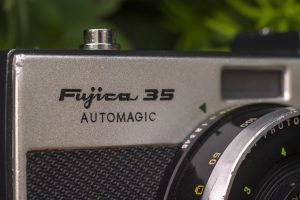
The Automagic actually looks like what a modern recreation of a “vintage” classic camera might look like, almost as if some Kickstarter campaign had created this to appeal to people like me. It’s angles and layout are unlike any other camera I’ve ever seen either today or from yesteryear. The majority of the camera is made from some type of cast metal rather than Bakelite like many others from the early to mid 20th century. It is definitely not brass or a lightweight metal like aluminum as it’s too heavy and I can see a silverish color in a few spots where the paint has been scratched off. The front fascia is a lightweight stamped metal, probably tin, and all markings are silk screened on. Each of these processes are certainly not exclusive to modern cameras, but do indicate a later method of inexpensive manufacturing practices.
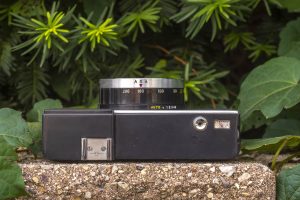
The Fujica 35 Automagic embraces the “auto” part of it’s name with a rather simplistic set of controls. If you are a fan of clean and barren top plates, this is the camera for you. Featuring an accessory shoe, threaded shutter release and exposure counter among a sea of dark gray paint, there isn’t much else. Also visible from the top of the camera are settings around the shutter for film speed, and flash settings which I’ll explain later.
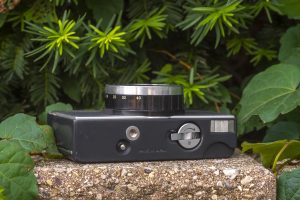
The bottom of the camera is little busier, with the rewind release button, 1/4″ tripod socket, fold out rewind knob, and door release contained in the same sea of dark gray paint.

Inside the film compartment, the “sea” is upgraded to an “ocean” of dark gray paint. Literally everything is the same color. There is no chrome polished film rails, there’s no anodized sprocket shaft,…oh wait, I missed it, the “fork” on the supply side for rewinding the film is made of shiny metal. Seriously though, I have never more appreciated Kodak’s colorful film “stickers” that they used on the insides of the door on their mid century cameras than I do now. Film loading is pretty standard, a new cassette goes on the left, and the take up spool on the right. The light seals were once made of foam and have since decayed, requiring their replacement. The previous image was shot before I did this, however.
Although I was unable to find a user manual for this camera, this camera is simple enough that one really isn’t necessary. The Automagic is intended to be used fully automatic via it’s built in selenium cell light meter. It uses a very simple twin blade shutter and is either open or closed at one of two shutter speeds. I’ve found conflicting information online suggesting the top speed is either 1/200 or 1/250, but frankly, this camera likely wasn’t precise enough to be either, so I would call it 1/200-ish.
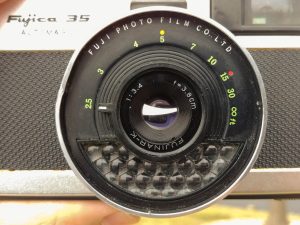
Like many inexpensive cameras of the era, there is no traditional iris in the shutter to limit light entering the film plane, rather there is a swinging piece of metal with a curved slit going down the center. At one end, the slit is very narrow, allowing the least amount of light, and the other is wide open, allowing all light through the lens’s maximum opening of f/3.4. In the image to the left, I opened the rear of the camera and held the shutter open with the setting at 3 (f/8) to show the strange curved opening of the “iris”. This swinging plate is continuously coupled to the meter and seems to always be moving regardless of the mode the camera is set to. As with all selenium meters, if the meter stops responding to light, the camera loses it’s automatic ability to restrict light.
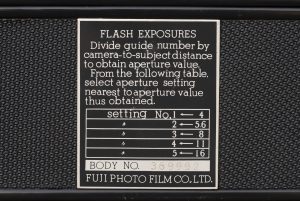
The shutter has two modes, each using a different shutter speed. With the ASA number set to any of the numbers 50-200, the shutter is fixed at a speed of 1/200-ish and the meter compensates the f/stops accordingly. The second set of numbers are flash Guide numbers and change the shutter speed to 1/40-ish. With the ASA number set to any Guide number from 10-40 you must follow the flash instructions on the rear door which requires disabling the automatic exposure mode on the front of the camera. The camera being reviewed here would only fire the shutter correctly at the faster speed. Any attempt to use the slower speed with the Flash Guide numbers would cause the shutter to stick open. Thankfully it would close properly when set to the faster speed, so that’s all I used.
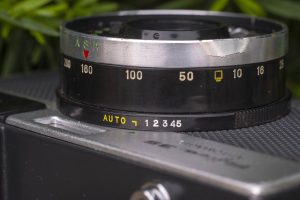
Disabling the automatic mode of the camera is accomplished by turning the ring around the shutter closest to the body away from the “Auto” setting to one of the numbers 1 – 5. These numbers directly correspond to f/stops from f/4 – f/16 and allow you to manually set the shutter. In flash mode, you control light by varying your f/stops with a fixed shutter speed of 1/40-ish. A really nice feature of the camera is that these manual aperture settings also work with the shutter at the faster speed which means it can be used even if the meter is dead or not accurate. Many inexpensive auto exposure cameras of the late 50s/early 60s are effectively paperweights when their meters die, but not the Automagic.
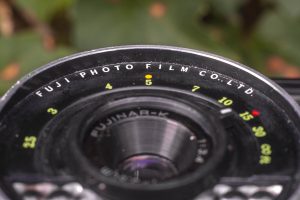
With a choice of one or two shutter speeds and manual or automatic aperture settings, the only other control you need to know is changing focus, which is done by rotating the front ring around the lens. The front element focus has a range of 2.5 feet to infinity. There is a yellow and a red dot above the 5 and 15 foot marks, which I assume is some type of fixed focus setting for portraits and group shots. Without the manual however, I can’t really be sure. The 3.8cm focal length of the lens suggests a pretty wide depth of field in most scenes, so focus accuracy isn’t something you need to be too concerned with in most shooting situations.

The viewfinder of the Automatic is acceptably large for a camera of this era. It’s larger than that of a Kodak Retina IIc but smaller than a Voigtländer Vitomatic. Showing a full 3.8cm image in a greenish blue tinted frame, the only thing visible in the viewfinder is a white horizontal line with a red mark on the right. Under normal operation, you should see a black needle move across this line from red (underexposure) to white (proper exposure). There are no numbers or any other kinds of markings on the line indicating how much light, or what f/stop the camera is going to use. If the needle moves to the red, or off to the right entirely, you either have to get creative and use the slower shutter speed in flash mode, or just wait until you have better light. Although primitive, it’s a welcome feature for a camera of this age where you can see some clue of exposure projected within the viewfinder image.
The entire experience of shooting with the Automagic is pretty consistent and with no surprises. It looks just a bit nicer than you’d expect from a low end AE camera from the early 60s, it has a nicer than you’d expect viewfinder, and the lens is nicer than a simple meniscus or doublet lens like you might expect from a lesser camera. But how do the images look?
My Results
With only a single 1/200-ish shutter speed at my disposal, I chose a fresh roll of Fuji 200 to maximize the potential for success with the selenium meter. I had planned on shooting some shots in Auto mode, and others manually setting the f/stops to see if one was better than the other. Using a 200 speed film with an approximate 1/200 shutter speed meant I could use Sunny 16 in good lighting.
I had my doubts about what kind of images I would get from the Fujica 35 Automagic. The simplistic nature of the camera and its rudimentary auto exposure system didn’t exactly inspire confidence, but I quite enjoyed the process so I figured if I got anything at all, I’d be happy.
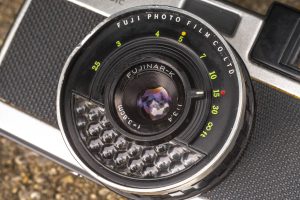
I’m pleased to say (not that I need to, as the gallery comes BEFORE these words) that the images came out quite nice. There’s some heavy vignetting evident in nearly all of the pictures which add a distinct look not visible in images shot from other cameras. Oddly, the vignetting is on both sides of every image, rather than near the corners like you would expect to see. I wonder if this is more a side effect of the twin-blade shutter that opens and closes from the sides. Perhaps the shutter is a little sluggish and is making the edges darker, as opposed to “normal” lens vignetting that is only visible near the corners.
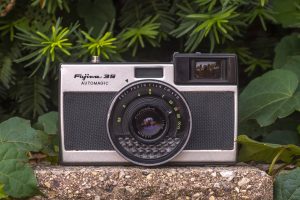
Regardless of why they look like this, I quite liked the images. Center sharpness is quite good, with some softness around the edges. Amazingly, the auto exposure functioned properly as nearly every image came out properly exposed. Even the images I shot indoors at the diner came out quite nice and added to the vintage appeal of the camera.
Overall, I am really happy I added this camera to my collection. On my rating scale above, it doesn’t quite get the high numbers of other illustrious cameras like the Voigtländer Bessamatic, Nikon S2, or Kodak Medalist, but that’s OK. Not everything has to be the best. This camera was never designed to be the best at anything. I think I paid like $5 for this thing, and for that money, I’ll take a “good enough” camera that is fun to use, looks good, and makes good images all day long!
Additional Resources
http://camera-wiki.org/wiki/Fujica_35_Automagic
http://licm.org.uk/livingImage/Fujifilm_Automagic-35.html
https://austerityphoto.co.uk/the-fujica-35-automagic-review-futuristic-50s-automagic/
http://kanscamera.sakura.ne.jp/html/p221.html (in Japanese)
http://www.hat.hi-ho.ne.jp/m-bon/camera/camera_038.html (in Japanese)

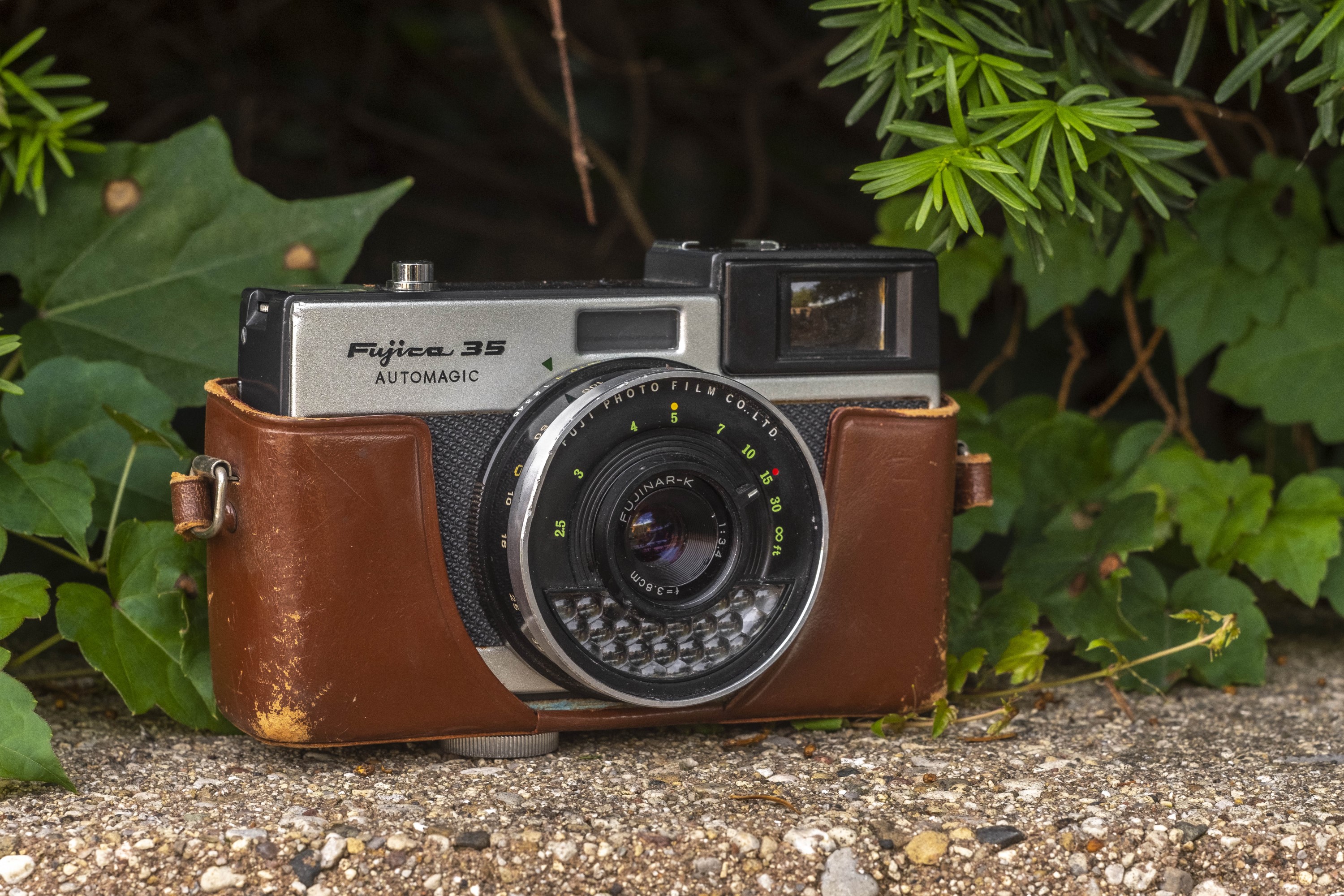












Thanks for the link Mike. I struggled with the age of this too. Collectiblend lists it as 1958 ( http://collectiblend.com/Cameras/Fuji-Optical/Fujica-35-Automagic.html ) as do a few other authors whilst others go for a early 60’s date. . Like you I can find examples of early trade adverts in the early 60’s but I can’t find many 1958 or ’59 catalogues to prove it wasn’t around. iT becomes important if you consider the history of the automatic camera. If 58 it would make it one of the first fully auto exposure cameras
Glad you liked it – its a hidden gem
I definitely went back and forth whether to leave the date as 1958 like many sites and the McKeown’s guide suggest. The reason I switched to 1961, as much as I respect the sources online that all say 1958, they’re all modern resources that likely are sharing the same information from Collectiblend, Camerapedia, and the McKeown’s Guide. I actually found Camera Guides from 1961 through 64 that show this as a current model but nothing prior to 1961.
Yeah, its possible the camera was available for 3 years before it showed up in those guides, but that just doesn’t seem likely. Plus, if this camera was produced from 1958 through 1964, you’d think it would be more common today.
While I have no evidence of this, my theory is that Fuji already had a line of good quality rangefinders like the 35-ML and this was created as an inexpensive entry level model for western audiences to help gain recognition of their brand.
Of course, this could all be wrong and it really was available in 1958. Im always open to correcting my articles, but for now I’ll keep it at 1961 until I find some kind of period correct evidence otherwise!
In any case, thanks for the kind words, I had read your review prior to getting this camera and it was one of the reasons I was so excited about it! 🙂
Mike,
I love it when you unearth these classic camera gems. It is sort of like an Olympus Trip 35 in most respects, but certainly has a different design. McKeown’s has the date as circa 1958, so there is some uncertainty on when it was introduced.
Best wishes,
Mark
G’day,
My Grandfather had this camera, and saved the user manual. Amusingly we only found one camera among my grandfather’s stuff, but four manuals, so he was better at holding to manuals than cameras.
A couple of notes from the manual:
1) The strangely modern trend continues in the manual; it’s short (16 pages including the cover, and two pages of ads) like most modern manuals, with lots of pictures and orange boxes. The most obviously non-modern part is the Japanese guy in a suit holding the camera in some of the demo pictures.
2) You’re right about the yellow and red dot on the focus: “A good rule of thumb to follow is shoot portrait closeups at 5 feet (yellow dot) and group shots at 15 feet (red dot).” pg3
3) The two ads in the back of the manual are for the “Fujica Electric Eye 35EE” and the “Fujica Fully Automatic Electronic Eye ZOOM 8 Movie Camera”; (Yes, one’s “Electric” and one’s “Electronic”) Given that the 35EE is apparently from 1961, this edition of the manual at least must post-date the 1958 date.
Hi Mike!
Thank you so much for this. I recently picked one of these up at a small garage sale type stall at a market here in New Zealand! My slider on the bottom doesn’t slide across completely and I believe there is still an old roll of film left inside that wasn’t able to be retrieved before the slider got stuck. What I found really interesting is the writing on the back panel. While yours is completely in English, mine is 99% in Japanese! I had absolutely no clue what it meant as I am just a fan of old things and not cameras in general, and honestly thought it might’ve been a guide as to how to replace a film roll before I saw what yours said.
I have no idea if you are still actively posting on here but it was so great to finally learn a bit more about this pretty little thing, and hopefully the mystery of the different languages on the back panels will be found out! Maybe my camera was sold in Japan whilst yours was sold in North America as I think you said. Still such a a great find and I hope to get the slider repaired soon so I can get to shooting some photos!
Cheers, Anastasia
Anastasia, thanks for the kind words! Glad I was able to help you learn more about your camera. Since writing this article, I found a copy of the original instruction manual. One of these days, I will have to scan it in and post it.
Thank you for the post.
I inherited this exact camera from my grandfather and really cannot find much information on it/how to use it… this is helpful! I just picked up some film for it today and am excited to try it out 🙂
I just found this camera at a thrift store. The lens seems to be a bit wobbly but i would love to be able to restore if if it is at all possible. Would you have any tips on how to go about this?
Thanks In advance!
I am really sorry, I would love to help you, but I have no experience repairing this model. From a quick look, it does not look obvious how to remove the lens. Even if it was, fixing a wobbly lens usually requires a complete tear down of a camera and is not an easy repair.